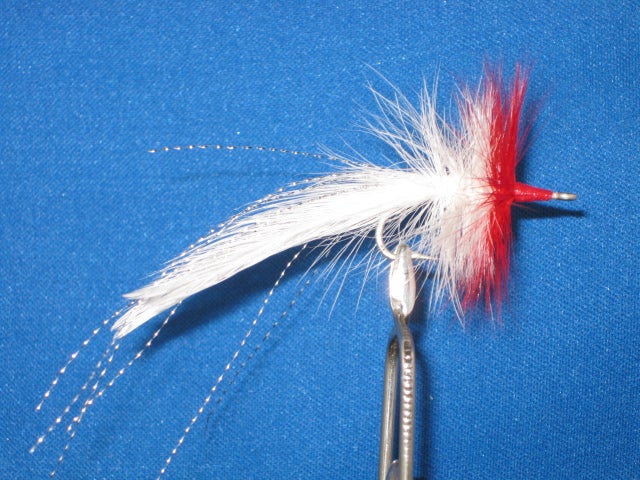peregrines
Super Moderator/Fly Swap Coordinator
- Messages
- 4,009
- Reaction score
- 30
[TABLE="head]{colsp=2}
Seaducer |

Type of fly | Saltwater streamer
Originator of pattern if known | Actually said to be an old fresh water fly for largemouth from the 1880's called the "Red and White Hackle", it was popularized by Homer Rhodes in the 1940's as the "Homer Rhodes Streamer", and renamed the "Seaducer" by an outdoor writer in the 1980's.
Tied and Submitted by | peregrines
Level of tying experience needed to tie this pattern |Beginner, a fairly simple pattern using basic tying skills.
Materials listed in order of tie in:|
Hook | Standard Saltwater size 4-4/0, Mustad 3407DT size 1 used here. If you'll be using this for smallmouth or largemouth bass in freshwater and are not worried about corrosion, you can use any standard shank hook size 6 or so and up.
Thread | Your choice. Red Danvilles Flat Waxed Nylon used here
Tail | 2 or 3 pairs of saddle or cape feathers, splayed (tied in dull concave sides facing out). Strands of Flashabou or Krystal Flash optional. White strung saddles and Pearl Krystal Flash added on each side of tail here.
Body| Just a thread base
Hackle Collar | Formed by dense wraps of 5 hackles with barbs about 1.5x the width of the hook gap. 3 densely wrapped hackles, same color as tail wrapped towards front of hook, followed by 2 more hackles of a contrasting collar nearest to eye. Red/White version here.
Wing | none
Throat | none
Head | thread
Special tying notes | Experiment with other color versions Chartreuse/Yellow. Red/Yellow, Grizzly/Yellow, Purple/Black, Grizzly/White etc. This is a simple fly to tie. It can also be tied with a weighted shank for fishing over wrecks for cobia etc.
Target species | snook, tarpon, cobia, shark, sailfish, redfish, smallmouth and largemouth bass
Fishing notes | A slow retrieve with periodic twitches allows the fly to suspend in the water column and causes the tail to kick and hackles to breathe so it has a lot of action. A great fly for stained water in the everglades backcountry. This fly imitates a variety or things from shrimp to crabs to squid, as well as being an attractor type of pattern.
[/TABLE]
Seaducer
Seaducer |

Type of fly | Saltwater streamer
Originator of pattern if known | Actually said to be an old fresh water fly for largemouth from the 1880's called the "Red and White Hackle", it was popularized by Homer Rhodes in the 1940's as the "Homer Rhodes Streamer", and renamed the "Seaducer" by an outdoor writer in the 1980's.
Tied and Submitted by | peregrines
Level of tying experience needed to tie this pattern |Beginner, a fairly simple pattern using basic tying skills.
Materials listed in order of tie in:|
Hook | Standard Saltwater size 4-4/0, Mustad 3407DT size 1 used here. If you'll be using this for smallmouth or largemouth bass in freshwater and are not worried about corrosion, you can use any standard shank hook size 6 or so and up.
Thread | Your choice. Red Danvilles Flat Waxed Nylon used here
Tail | 2 or 3 pairs of saddle or cape feathers, splayed (tied in dull concave sides facing out). Strands of Flashabou or Krystal Flash optional. White strung saddles and Pearl Krystal Flash added on each side of tail here.
Body| Just a thread base
Hackle Collar | Formed by dense wraps of 5 hackles with barbs about 1.5x the width of the hook gap. 3 densely wrapped hackles, same color as tail wrapped towards front of hook, followed by 2 more hackles of a contrasting collar nearest to eye. Red/White version here.
Wing | none
Throat | none
Head | thread
Special tying notes | Experiment with other color versions Chartreuse/Yellow. Red/Yellow, Grizzly/Yellow, Purple/Black, Grizzly/White etc. This is a simple fly to tie. It can also be tied with a weighted shank for fishing over wrecks for cobia etc.
Target species | snook, tarpon, cobia, shark, sailfish, redfish, smallmouth and largemouth bass
Fishing notes | A slow retrieve with periodic twitches allows the fly to suspend in the water column and causes the tail to kick and hackles to breathe so it has a lot of action. A great fly for stained water in the everglades backcountry. This fly imitates a variety or things from shrimp to crabs to squid, as well as being an attractor type of pattern.
[/TABLE]
Last edited:
